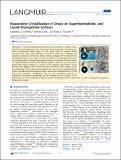Evaporative Crystallization in Drops on Superhydrophobic and Liquid-Impregnated Surfaces
Author(s)
McBride, Samantha Ann; Dash, Susmita; Varanasi, Kripa
DownloadAccepted version (2.386Mb)
Terms of use
Metadata
Show full item recordAbstract
Mineral-fouling induced corrosion and deterioration of marine vessels, aircraft, and coastal structures is due in part from structural intrusion of crystals grown from ocean-generated saline drops. As such, much work has explored surface treatments that induce hydrophobicity or introduce barriers for antifouling and corrosion prevention; however, the efficacy of these strategies will be altered by the underlying substrate texture. Here, we study the behavior of evaporating saline drops on superhydrophobic and liquid-impregnated surfaces as a function of surface texture. On superhydrophobic surfaces, four disparate regimes (which are not observed for particle-laden drops) emerge as a function of the substrate solid fraction: Cassie-pinning, Cassie-gliding, Cassie-Wenzel transition, and Wenzel. These regimes control the morphology of the resultant crystal deposits. In contrast to the superhydrophobic surfaces, spreading liquid-impregnated surfaces demonstrate minimal influence of solid fraction on evaporative crystallization. The area, area localization, timescale of evaporation, and deposit morphology are all normalized by the presence of the lubricating layer, thus introducing an efficient method of eliminating crystal "coffee rings" as well as reducing the potential for fouling and corrosion.
Date issued
2018-04Department
Massachusetts Institute of Technology. Department of Mechanical EngineeringJournal
Langmuir
Publisher
American Chemical Society (ACS)
Citation
McBride, Samantha A. et al. "Evaporative Crystallization in Drops on Superhydrophobic and Liquid-Impregnated Surfaces." Langmuir 34, 41 (April 2018): 12350–12358. © 2018 American Chemical Society
Version: Author's final manuscript
ISSN
0743-7463
1520-5827